by Heather McCargo
A native hedge will bring beauty and vitality to your landscape. While a fence may be a great solution in a tight space, shrubs can be planted to create a “living fence” for enclosure, privacy, and beauty. Shrubs add three-dimensional diversity to a landscape and provide important year-round habitat for fauna such as birds, pollinating insects, and other small creatures.
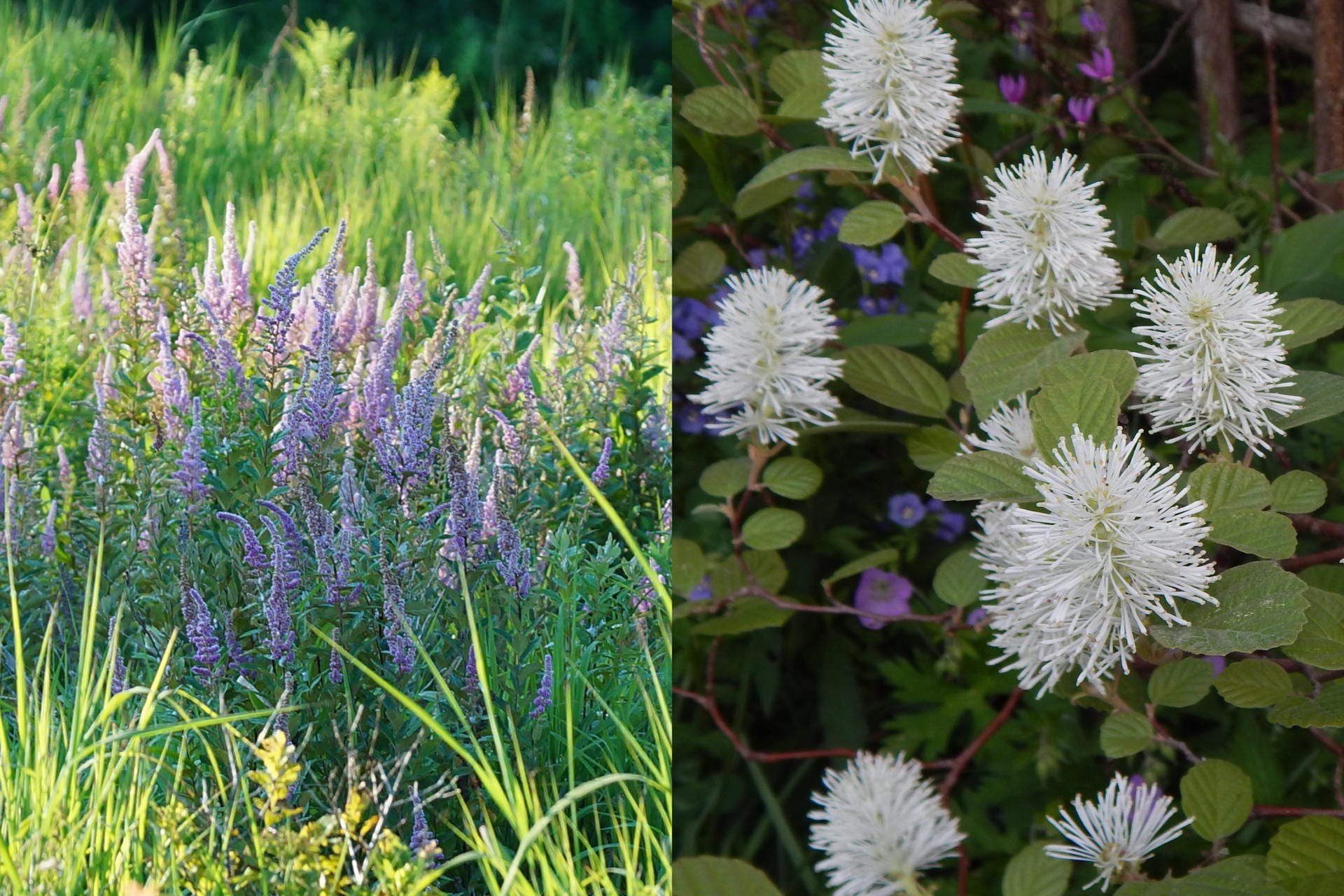
Meadowsweet (Spirea tomentosa) and dwarf witch-alder (Fothergilla gardenia) are a winning combination for a small hedge. Photo: Wild Seed Project
Living hedges of native shrubs may take different forms. A traditional garden hedge is often just one species, and indeed, many native shrubs make a handsome formal hedge. Also, there are several petite native shrubs that can create beautiful hedges for smaller spaces. For larger areas, there are many ways you can group together different species to create a dynamic hedgerow with multiple wildlife benefits. Imagine if all our landscapes, from the urban to the rural, were connected via a network of hedgerows. This linking of habitats would be a huge boost to plant and animal diversity. It would also provide ecosystem resiliency, support animal and plant migration, and enable fauna and flora populations to shift with our warming climate.
Small Hedges for Tight Spaces
For a small hedge to enclose a patio or separate a front yard from a street, there are some great native shrubs that make a more interesting hedge than a heavily sheared exotic shrub such as privet. Replacing paving or lawn with a hedge of just 30 feet long by 2.5 feet wide will create 75 square feet of native ground cover, plus the above ground growth of the woody branches. Birds will perch, pollinators will forage and nest, and snow will alight on the twigs, giving pleasure to you all year long.
My top choices for a small hedge are dwarf witch-alder (Fothergilla gardenia) and pink meadowsweet (Spirea tomentosa). These species grow 3-4 feet tall in part-to-full sun in soils that are well drained or wet (once established, they have good drought tolerance). For a shady location, an outstanding shrub with a more orderly look is leatherwood (Dirca palustris), which grows from the ground with a single stem and tidy, distinctive low branches.
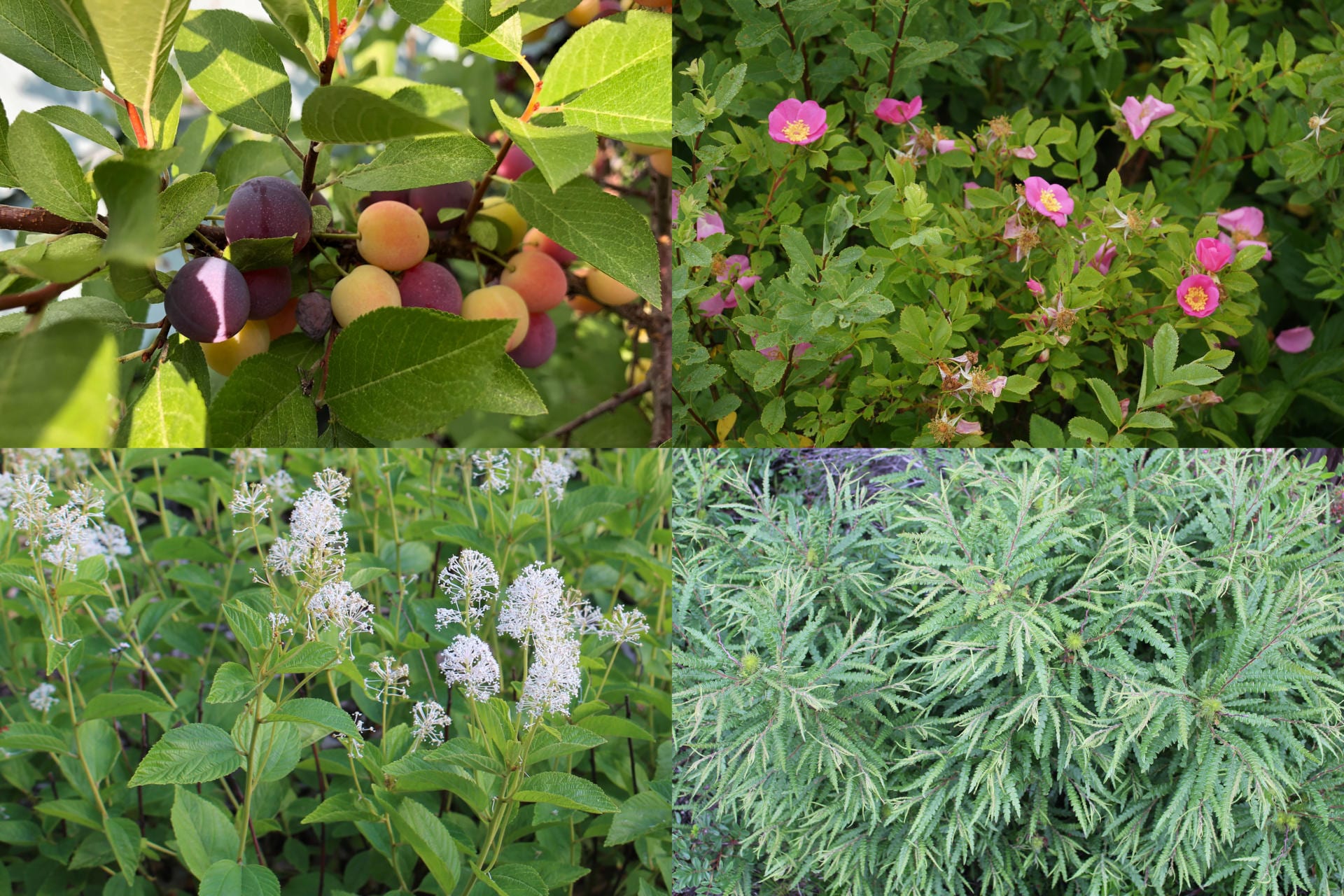
Clockwise from upper left, beach plum (Prunus maritima), wild rose (Rosa virgininana), sweet-fern (Comptonia peregrina), and New Jersey tea (Ceanothus americana) work well in very dry conditions in full sun. Photo: Wild Seed Project
For extremely dry, sandy, or gravelly soil in full sun (where the Asian rugosa rose is often the traditional choice), there are many lower stature native shrubs to choose from: bayberry (Morella caroliniensis), New Jersey tea (Ceanothus americana), sweet-fern (Comptonia peregrina), wild rose (Rosa virgininana), dwarf shadbush (Amelanchier spicate), chokeberry (Aronia melanocarpa), and shrubby St. Johnswort (Hypericum prolificum). Ranging in height from 2-6 feet (the taller stems can be pruned back to the ground every few years if a lower height is desired), these shrubs will spread from their root system. Plant them next to driveways, paths, or mowed lawn to keep their horizontal growth in check.
For part-to-full shade locations, along with Dirca there are other small stature shrubs including maple-leaved viburnum (Viburnum acerfolium), yellow bush honeysuckle (Diervilla lonicera), lowbush blueberry (Vaccinium angustifolium), and yellowroot (Xanthorhiza simplicissima). These shade-loving species also spread from their root system, so to maintain your ideal hedge depth, you will need to contain via edging, paving, or mowing.
Larger native shrubs can also be planted as single-species hedges. A couple of my favorites are arrowwood (Viburnum dentatum), wild raisin (Viburnum nudum, v. cassinoides), and hazelnut (Corylus Americana). Plant a groundcover and you will have a long season of interest for the humans and wildlife.
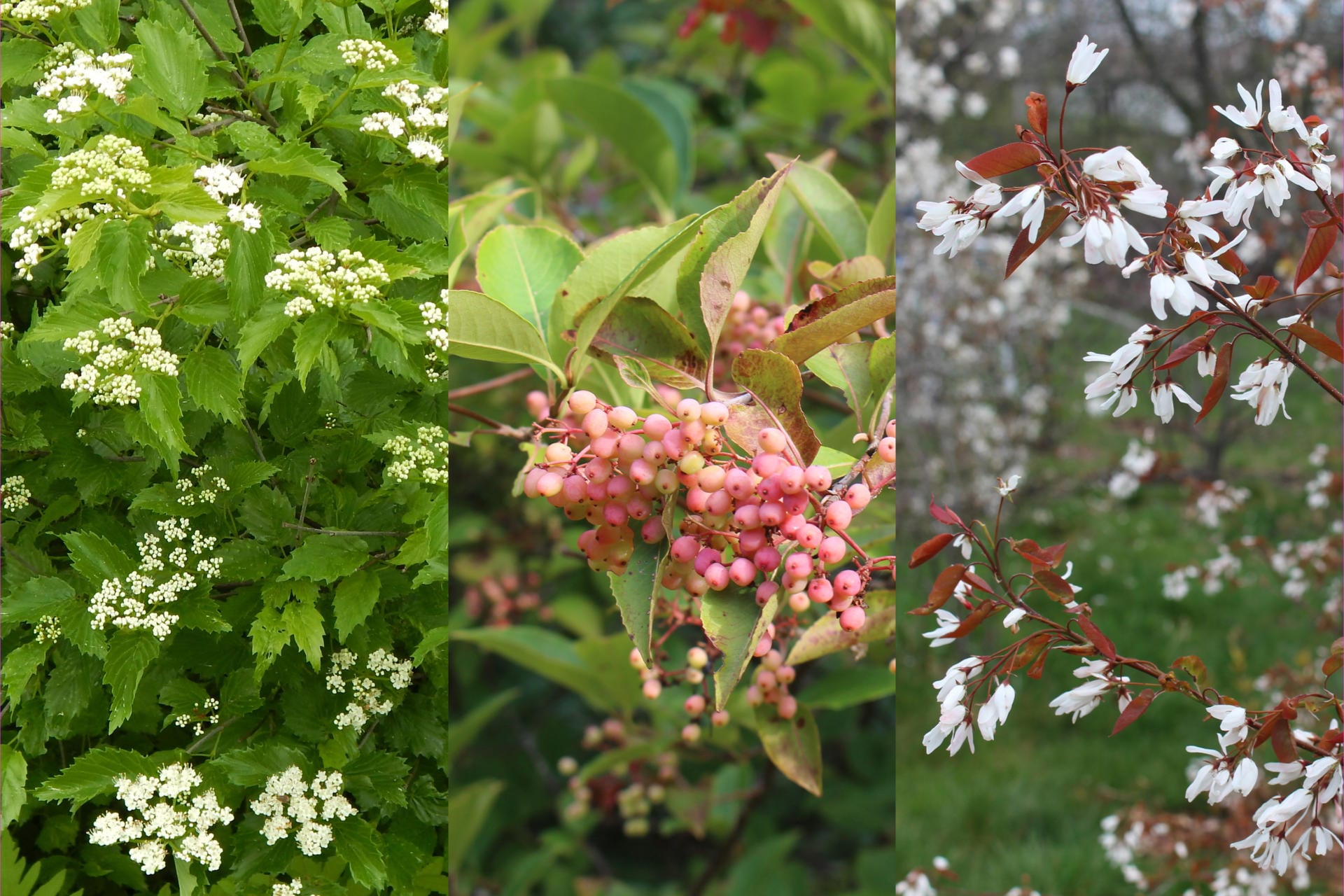
From left, Viburnum dentatum, Viburnum cassinoides, and Amelanchier are all beautiful additions to a mixed hedgerow. Photo: Wild Seed Project
Multispecies Hedgerows Yield Bigger Ecological Benefits
England was once famous for its beautiful hedgerows, many of them in existence since medieval times. The Green Revolution of the mid- to late-twentieth century, which greatly expanded agricultural production in the British countryside, mostly eliminated this landscape feature, causing a significant number of British plant and animal species to disappear. Hedgerows have an important role to play in restoring biodiversity in North America, especially in our human-dominated landscapes, where the native vegetation has been retreating since the first European colonizers arrived. Fortunately, there is an incredible diversity of native woody shrubs and small trees that can be chosen to help restore native flora to our urban and suburban landscapes.
Hedgerows differ from hedges in several ways. The goal is not a uniform look, but instead a diverse planting of at least a dozen species of woody plants, from shrubs to small trees, along with herbaceous groundcovers at their base, all chosen with similar demands of soil type, moisture, and sunlight. Think layers of vegetation: an occasional small tree rising up above a mixture of shrubs, some of considerable width, others with tall arching stems under-planted with lower shrubs, so that every available space is covered in growth. This creates a tremendous amount of habitat and leaves little space for opportunistic weeds to grow.
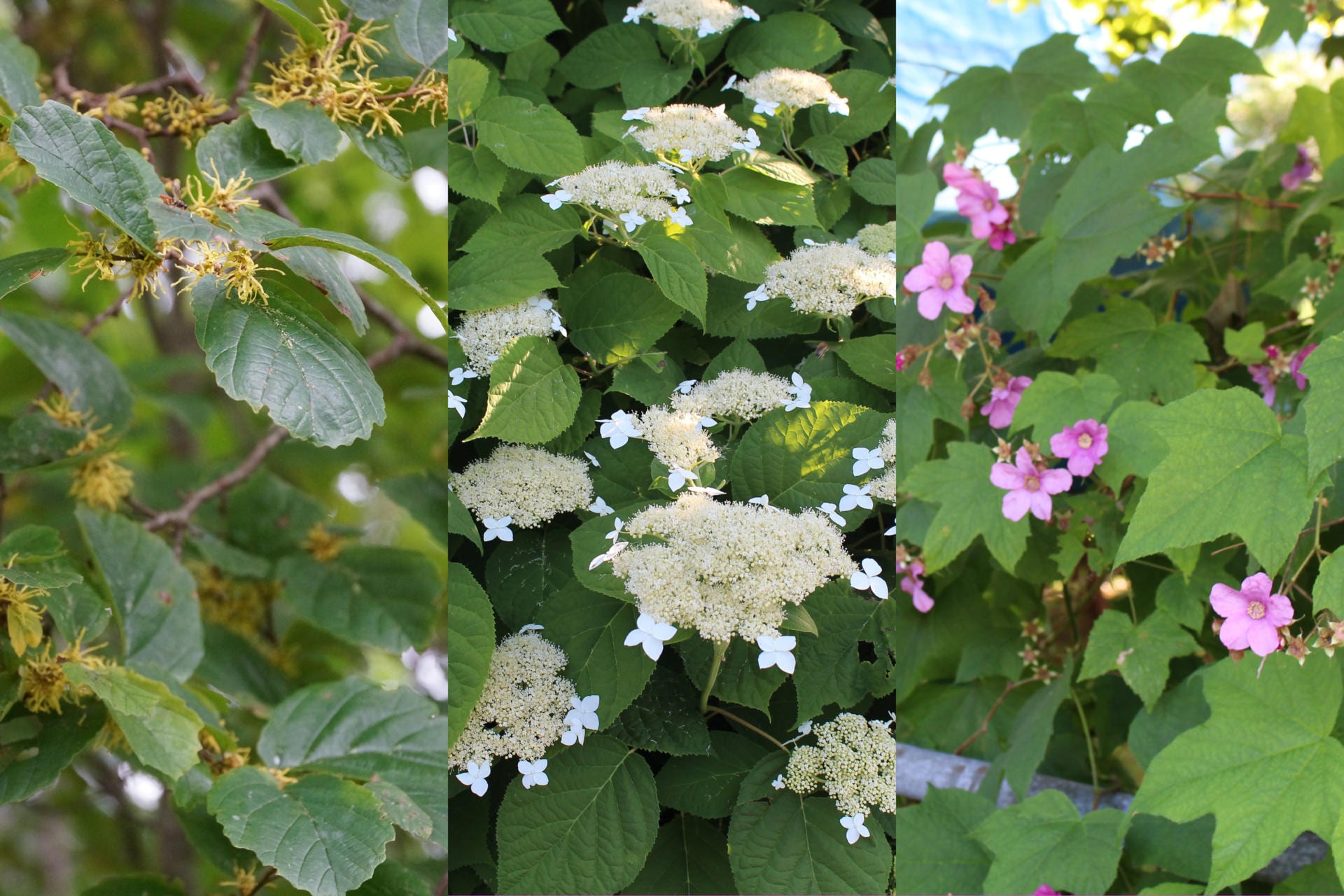
From left, witch hazel (Hamamelis virginiana), smooth hydrangea (Hydrangea arborescens), and purple flowering raspberry (Rubus odoratus) perform well in shady sites. Photo: Wild Seed Project
A hedgerow should be a minimum 6 feet wide, with 15 feet or more as the ideal. Connecting the hedgerow to other vegetation, such as woodlands, meadows, wetland, existing yard trees, and neighboring yard’s plantings, will link disconnected habitats and assist plants and animals in their movement. The larger the hedgerow, the greater the benefits to wildlife. It is especially important to have a long season of blooms for pollinators (see Wild Seed Project’s publication on bloom times for pollinator support). A diversity of species also provides the most resilience when a new exotic pest appears on the scene and one species gets defoliated that season.
Hedgerow Plants for Shady Sites
For hedgerows in shady areas such as under tree canopies or next to a building, here are some recommended woody plants:
- Shadbush (Amelanchier canadensis & A. laevis)
- Pagoda dogwood (Swida alternifolia)
- Big-bracked dogwood (Benthamidea florida)
- Hazelnut (Corylus americana)
- Hobblebush (Vibunum lantanoides)
- Smooth hydrangea (Hydrangea arborescens)
- Striped and Mountain maple (Acer pensylvanicum & spicata)
- Witch hazel (Hamamelis virginiana)
- Spicebush (Lindera benzoin)
- Red buckeye (Aescelus pavia)
- Purple flowering raspberry (Rubus odoratus)
- Pawpaw (Asiminia triloba)
- Red elderberry (Sambucus racemosa)
- Summersweet (Clethra alnifolia)
- Azalea (Rhododendron prinifolium, R. viscosum)
- Ironwood (Carpinus caroliniana)
Plant these shrubs with a groundcover of herbaceous ferns and wildflowers (see Wild Seed’s blog post on native groundcovers).
Sunny Hedgerows
For a mostly sunny site with mesic soil (medium moisture and fertility), here are some recommendations:
- Shadbush (Amelanchier spp)
- Wild plum (Prunus americana; and wild cherry species)
- Hawthorne (Craetageus spp.)
- Hazelnut (Corylus americana)
- Chokeberry (Aronia spp.)
- Redbud (Cercis canadensis)
- Bottlebrush buckeye (Aescelus parviflora)
- Shrub dogwoods (Swida racemosa, S sericea)
- Viburnums (Viburnum opulus, V. americanum, V. lentago, V. nudum, V.dentatum)
- Meadowsweet (Spiraea alba, S. tomentosa)
- Sweetbay (Magnolia virginiana)
- Arborvitae (Thuja occidentalis)
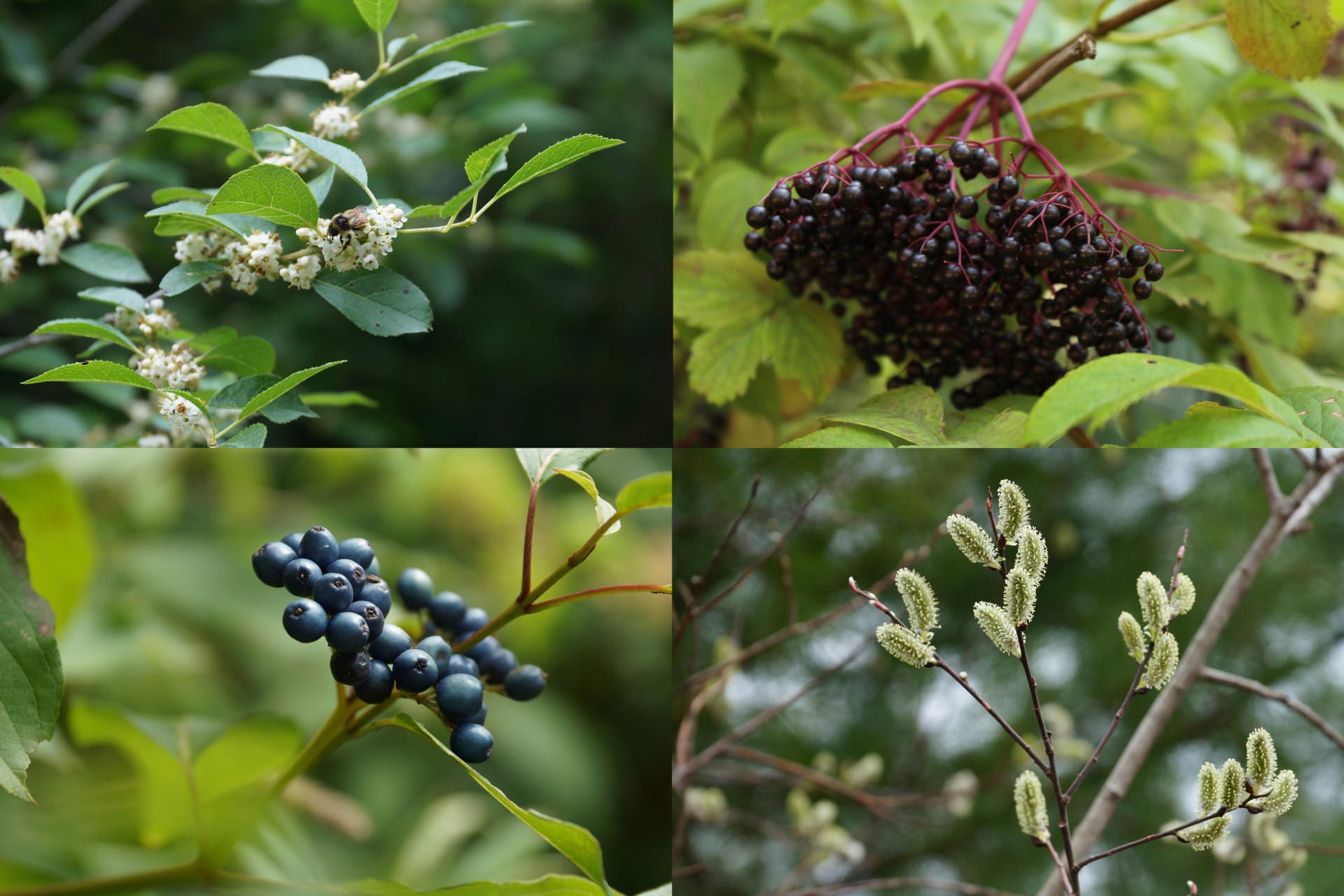
Clockwise from upper left, winterberry (Ilex verticillata), elderberry (Sambucus nigra), pussy willow (Salix spp.), and silky dogwood (Cornus amomum) all thrive in wet sunny conditions. Photo: Wild Seed Project
Wet soils with sunny conditions have a range of excellent options:
- Pussy willow (Salix discolor)
- Sweetgale (Myrica gale)
- Rhodora (Rhododendron canadense)
- Elderberry (Sambucus nigra, spp.canadensis)
- Inkberry (Ilex glabra)
- Silky dogwood (Swida amomum))
- Summersweet (Clethra alnifolia)
- Buttonbush (Cephalanthus occidentalis)
- Winterberry holly (Ilex verticillata)
Lastly, for a hedgerow in sunny dry, sandy, or gravelly soil, here are some larger shrubs and trees to be added to the smaller, dry soil-loving species mentioned earlier:
- Beach plum (Prunus maritima)
- Sassafras (Sassafras albidum)
- Scrub oak (Quercus ilicifolia)
- Dwarf chinkapin (Quercus prinoides)
- Pitch pine (Pinus rigida)
- Gray birch (Betula populifolia)
- Eastern red cedar (Juniper virginiana)
- Sumac (Rhus spp.)
Let’s All Take Action
Whether you plant a small hedge with one or two species, or a large hedgerow, these living fences will expand habitat on your property, creating corridors for wildlife and for beauty.
About the Author
Heather McCargo is the founder and executive director of Wild Seed Project, a Maine based 501(c)3 nonprofit that works to increase the use of seed grown native plants in all landscape settings. Wild Seed Project publishes an annual magazine Wild Seed, sells seeds of locally grown wild type native plants, and educate the public so that a wide range of people can participate in increasing native plant populations.
***
Each author appearing herein retains original copyright. Right to reproduce or disseminate all material herein, including to Columbia University Library’s CAUSEWAY Project, is otherwise reserved by ELA. Please contact ELA for permission to reprint.
Mention of products is not intended to constitute endorsement. Opinions expressed in this newsletter article do not necessarily represent those of ELA’s directors, staff, or members.

